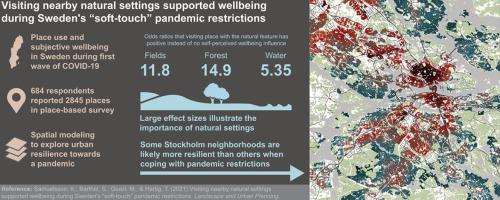Landscape and Urban Planning ( IF 9.1 ) Pub Date : 2021-07-02 , DOI: 10.1016/j.landurbplan.2021.104176 Karl Samuelsson 1 , Stephan Barthel 2 , Matteo Giusti 2 , Terry Hartig 3

|
The coronavirus pandemic entailed varying restrictions on access, movement and social behavior in populations around the world. Knowledge about how people coped with “soft-touch” restrictions can inform urban spatial planning strategies that enhance resilience against future pandemics. We analyzed data from an online place-based survey on 2845 places across Sweden that respondents abstained from visiting, visited with similar frequency, or visited more frequently in spring 2020 as compared to before the pandemic. In spatial logistic regression models, we relate geographical and sociodemographic properties of places (fields, forests, water, residential population density and daytime population density) to self-perceived changes in wellbeing from visiting the given place less or more often, respectively. Abstaining from visiting places with natural features located in areas of high residential density was associated with a self-perceived negative influence on wellbeing. Yet, fields, forests and water were strongly associated with places people claimed wellbeing benefits from during pandemic restrictions. The further a visited place was from the respondent’s home, the more likely it was to have a positive wellbeing influence. As an illustrative case, we map our models onto the landscape of Stockholm, showing that some neighborhoods are likely more resilient than others when coping with pandemic restrictions. Both the most and least resilient neighborhoods span the socio-economic spectrum. Urban planning will do well to enable equitable, easy access to natural settings by foot or bike, to increase pandemic preparedness as well as support climate change mitigation and biodiversity protection.
中文翻译:

在瑞典的“软接触”大流行限制期间,参观附近的自然环境有助于福祉
冠状病毒大流行对世界各地人口的出入、行动和社会行为造成了不同的限制。关于人们如何应对“软接触”限制的知识可以为城市空间规划战略提供信息,从而增强抵御未来流行病的能力。我们分析了对瑞典 2845 个地方进行的基于地点的在线调查的数据,与大流行前相比,2020 年春季受访者没有访问、访问频率相似或访问频率更高。在空间逻辑回归模型中,我们将地点(田野、森林、水、居住人口密度和白天人口密度)的地理和社会人口特征与因较少或更频繁地访问给定地点而带来的自我感知幸福感变化联系起来。避免参观位于高居住密度地区的具有自然特征的地方与自我感知的对幸福感的负面影响有关。然而,田野、森林和水与人们在大流行限制期间声称从中受益的地方密切相关。访问过的地方离受访者的家越远,就越有可能产生积极的健康影响。作为一个说明性案例,我们将我们的模型映射到斯德哥尔摩的景观上,表明在应对流行病限制时,一些社区可能比其他社区更有弹性。最具弹性和最不具有弹性的社区跨越社会经济范围。城市规划将很好地实现公平、方便地步行或骑自行车进入自然环境,



























 京公网安备 11010802027423号
京公网安备 11010802027423号